Atlanta United were back in the hunt for a manager to continue to implement the club’s philosophy of playing attractive and expansive football, but also a manager who can impose this style of football on his side whilst competing for major trophies.
Following the departure of Gerardo Martino, the Atlanta board went out and snapped up Frank de Boer to lead the club forward with his possession style of football, all the while breeding through players from the academy. However, the current Dutch national team manager’s style was more conservative and dogmatic than it was entertaining and after a disastrous spell, he was relieved of his duties.
Current Hearts manager Stephen Glass took over as the interim boss for a few months, preparing the team for the new season until a successor for de Boer was named. Almost five months after the Dutchman was sacked, Atlanta found their man, former Manchester United, and Real Madrid left-back, Gabriel Heinze.
Heinze had made a name for himself as an exciting and young coach during his time at Argentinos Juniors and Velez Sarsfield. At the former, he led them to two Copa Sudamericana qualifications before resigning. Heinze has been an outspoken disciple of Leeds boss Marcelo Bielsa and his style of football is very similar to that of a Bielsa team, having played with the influential Argentinian manager at international level, winning gold at the 2004 Olympics under ‘El Loco’.
So far, Heinze has won two of his three games in charge in competitive competitions, conceding no goals but scoring just two. His team has been playing a very interesting and exciting style of football.
This article will be a tactical analysis of Atlanta United under Heinze. It will be an analysis of the tactics that the 42-year-old has deployed with his current side as well as the team’s strengths and weaknesses.
Formations and lineups
Atlanta have been very fluid in their formations and their tactical switches throughout the first three competitive matches under their new manager. In the first competitive game of Heinze’s reign against Alajuelense in the CONCACAF Champions League, he deployed a 3-4-3 which quickly changed to a 3-4-2 following the red card to Brad Guzan in net.
In his second game in charge, the second leg of their CONCACAF Champions League last 16, the side were set up in more of a 4-3-3 which also shifted to a 4-2-3-1 at times throughout the match, similarly to their most recent match, the first of the MLS season, when Heinze’s team switched between the two systems again.
This is what the side looks like in a 3-4-3 if this is the starting formation that Atlanta will use going forward.
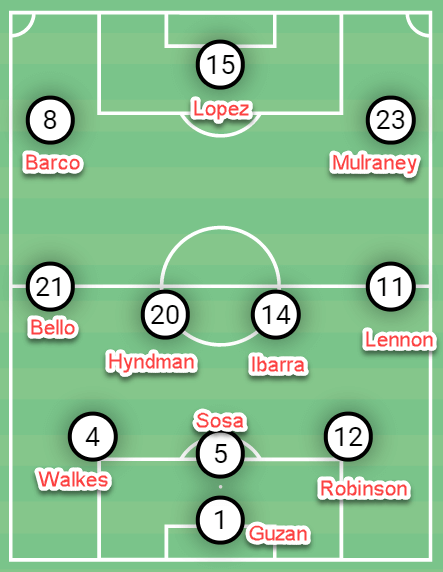
The experienced Guzan started in goal in two of the three games so far, protecting the goal behind Anton Walkes, Santiago Sosa and Miles Robinson. This is a rather young centre-back pairing but a very promising one at that.
The double-pivot ahead was Emerson Hyndman, formerly of Bournemouth, and Franco Ibarra, flanked by George Bello and Brooks Lennon, two very good young wingbacks who can also play at fullback.
Ezequiel Barco, Atlanta’s star man, was used out on the left with Jake Mulraney on the right supporting Lisandro Lopez up top.
The team’s system can be very fluid because of the players that Heinze uses. A principle that is key to Bielsa’s sides is that the players are capable of playing in multiple positions, which Heinze’s Atlanta can. Sosa is a very important player for the side tactically. The Argentinian is able to play as a number ‘6’ also and so can drop from the first line to the second line seamlessly, switching the team’s shape in the process, and his role within the side is very similar to a classic ‘libero’, much like the role that Frenkie de Jong is performing at Barcelona under Ronald Koeman this season.
When Heinze deploys more of a 4-3-3/4-2-3-1, Sosa is used as a single pivot and as part of a double-pivot.
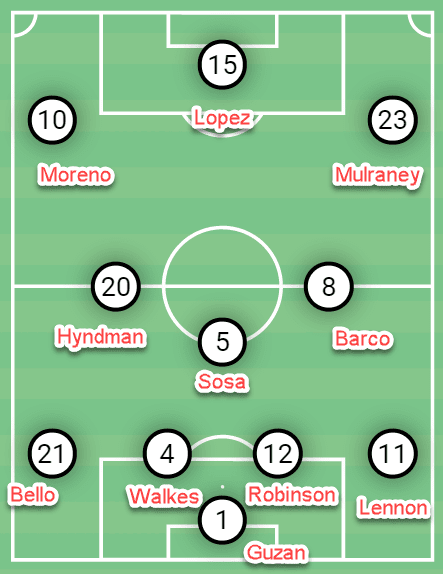
In the 4-3-3 that changes to a 4-2-3-1, the team stays relatively the same regarding the personnel, but some of the positions were slightly changed. Barco has been used as a central midfielder, pushing up between the lines and acting as a number ten with Hyndman dropping next to Sosa to create a double-pivot at times which creates the 4-2-3-1, whilst Marcelino Moreno also came back into the side.
As stated, this possession-based tactical system under Heinze is very reliant on fluidity in players’ positions to switch formations mid-game as opposed to the rigid structure we saw under de Boer during his time with the club.
Build-up phase
Part and parcel of a possession-based side is playing out from the back, a principle which Heinze has always implemented at his club. For the purposes of analysing Atlanta’s build-up structure, we will analyse how they have built up in the different variations so far during his reign in what is still a very small sample size.
In a 3-4-3, their structure in the build-up phase looks very much as it says on the tin but with Sosa pushing up beyond the opposition’s first line of pressure while the wide centre-backs push to the edge of the box to make room for the goalkeeper to be a third player in Atlanta’s first line.
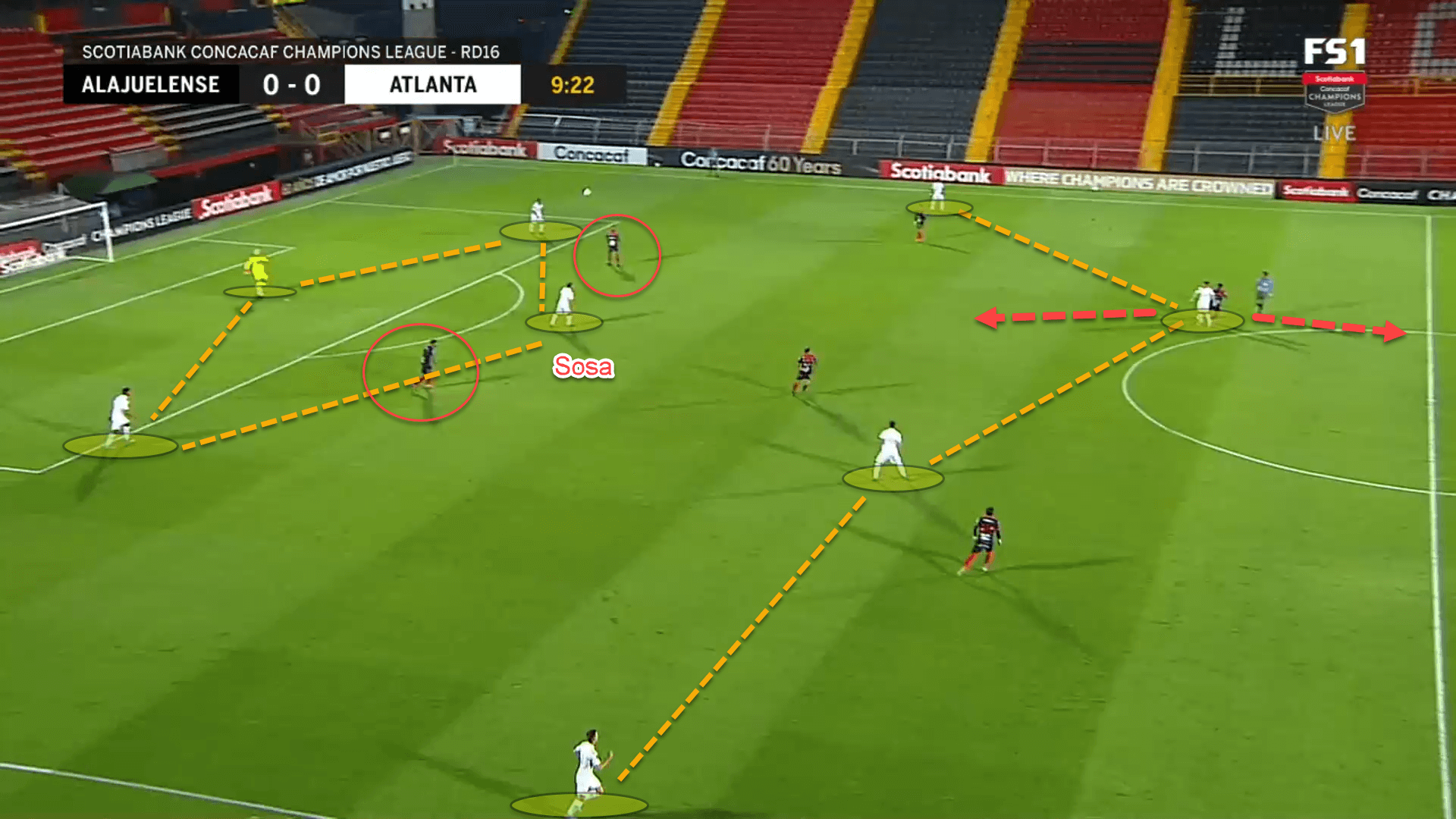
We can see this build-up phase structure from the image above. As Heinze is adamant on his goalkeeper being involved in the ball circulation and the ball progression from the first third of the pitch, it makes little sense to have a line of four circulating the ball against their opponent’s two-man first line of pressure.
So, Sosa positions himself behind the opposition’s first line of pressure while the two other centre-backs push wider to facilitate the goalkeeper being used in their first line. This creates a 3+1 vs 2 against the opposition’s first line of pressure, ensuring that they have numerical superiority in this area of the pitch, which allows for easy ball progression considering the quality of their players. Atlanta United averaged 72.33 progressive passes per 90 over Heinze’s last three games in all competitions with a 74.7 percent accuracy.
We also see from the previous image that the fullbacks push up slightly higher, roughly 15-20 yards outside the area during this phase, in line with the double-pivot who sit behind the opposition’s second line of pressure. Sometimes though, one of the players in the double-pivot pushes beyond the third line and positions himself between the lines, which creates a structure resembling a 2-1-3-1-3 with plenty of horizontal lines.
Another core principle of Atlanta’s structure under Heinze is the use of width. Atlanta’s wide players maintain the width of the pitch and during this phase, the wingers hug the touchline as well as the fullbacks which stretches the opposition, creating gaps to play through.
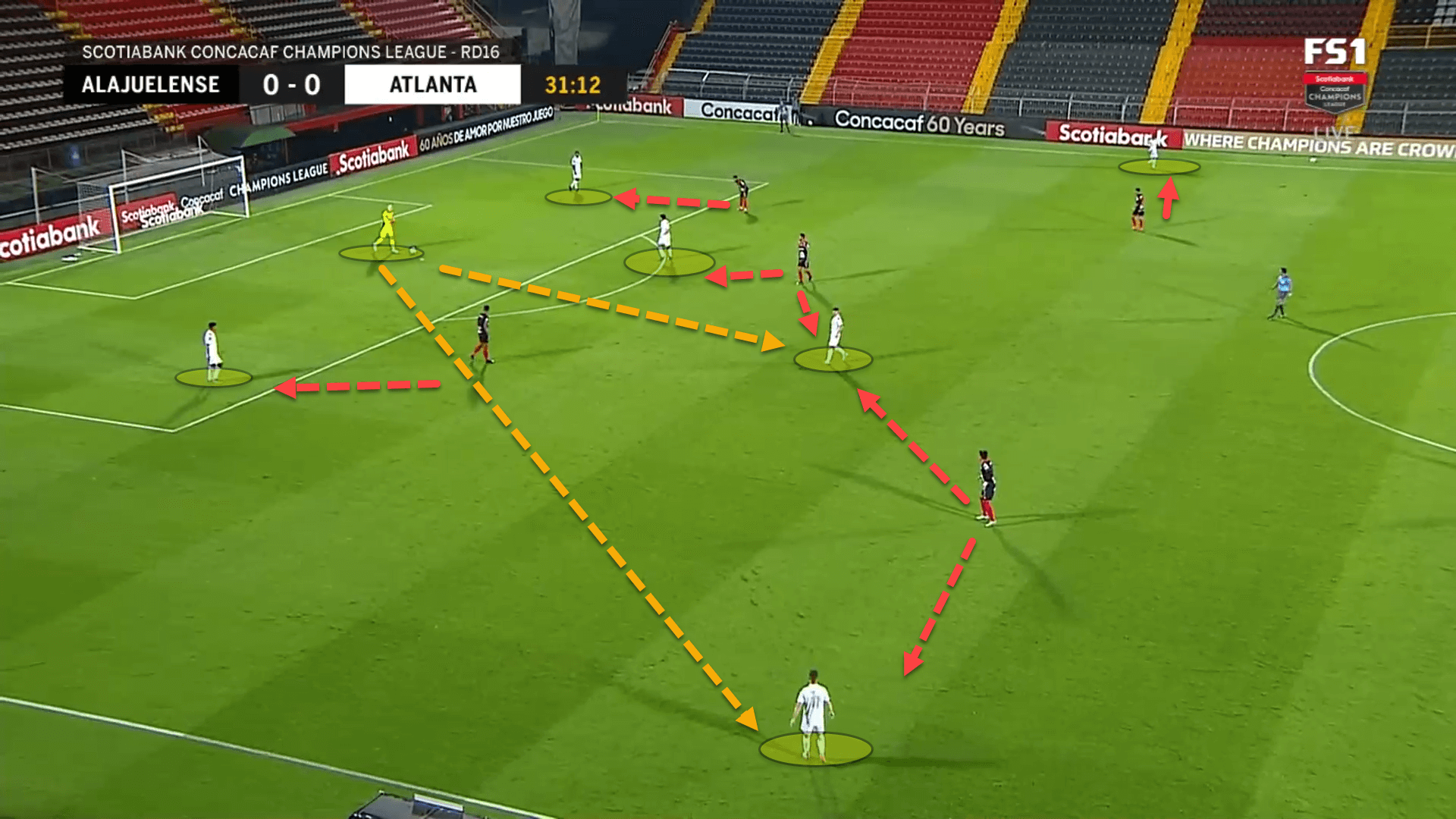
Here, we can see how Alajuelense struggled with how wide Atlanta set-up in this phase. A lot of the time, in the Costa Rican side’s man-oriented pressing scheme, the players were left to cover two different players which meant there were a lot of passing lanes for easy progression as can be seen above.
In the 4-3-3/4-2-3-1, Atlanta’s build-up structure was slightly different, although not that much. The difference was that instead of having Sosa in his own horizontal line on the pitch during this phase of play, he would form part of a double-pivot alongside Hyndman whilst Barco – the other central midfielder in Heinze’s second and third game respectively – plays between the lines to create a 4-2-3-1 structure.
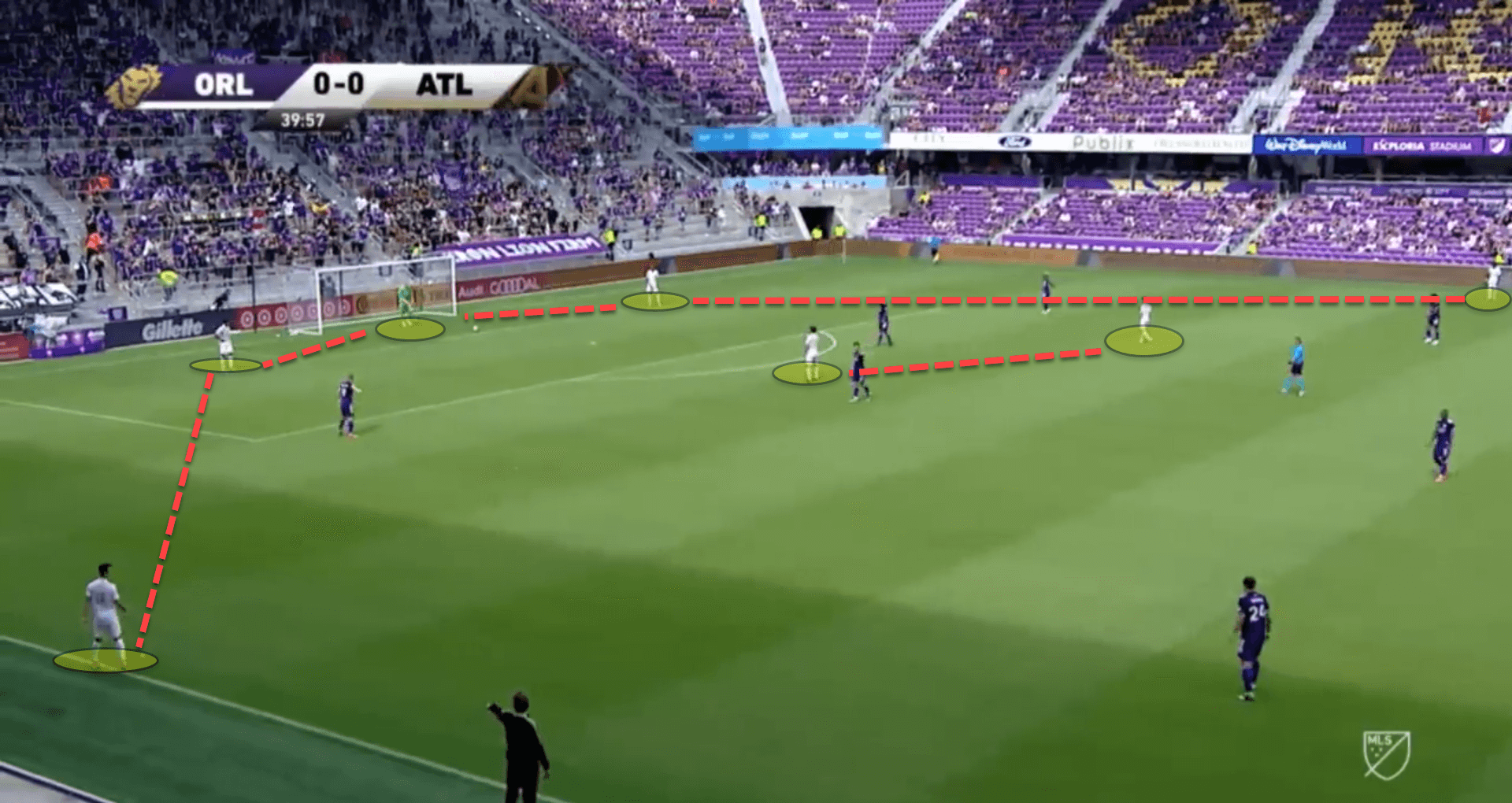
Here, we can see this set-up which was used against Orlando City in the previous game. There are fewer horizontal lines in this structure which looks to be a 2-4-1-3 as there are just four lines as opposed to five.
The fullbacks dropped slightly deeper too against Orlando in the goalless draw, roughly just 10 yards outside the box. The reason for this was because Heinze knew that the Orlando fullbacks would not commit fully to press the Atlanta fullbacks. As stated previously, during this phase of play, the wingers stay very wide and hug the touchline which stretches the opposition, but it also pins the opponent’s fullbacks.
By dropping the fullbacks while the opposition’s fullbacks were pinned back, Heinze knew that his side would have a free passing option to play out of Orlando’s press, particularly with Lennon on the right who is very comfortable on the ball, an option which they used numerous times to play out and progress up the pitch.
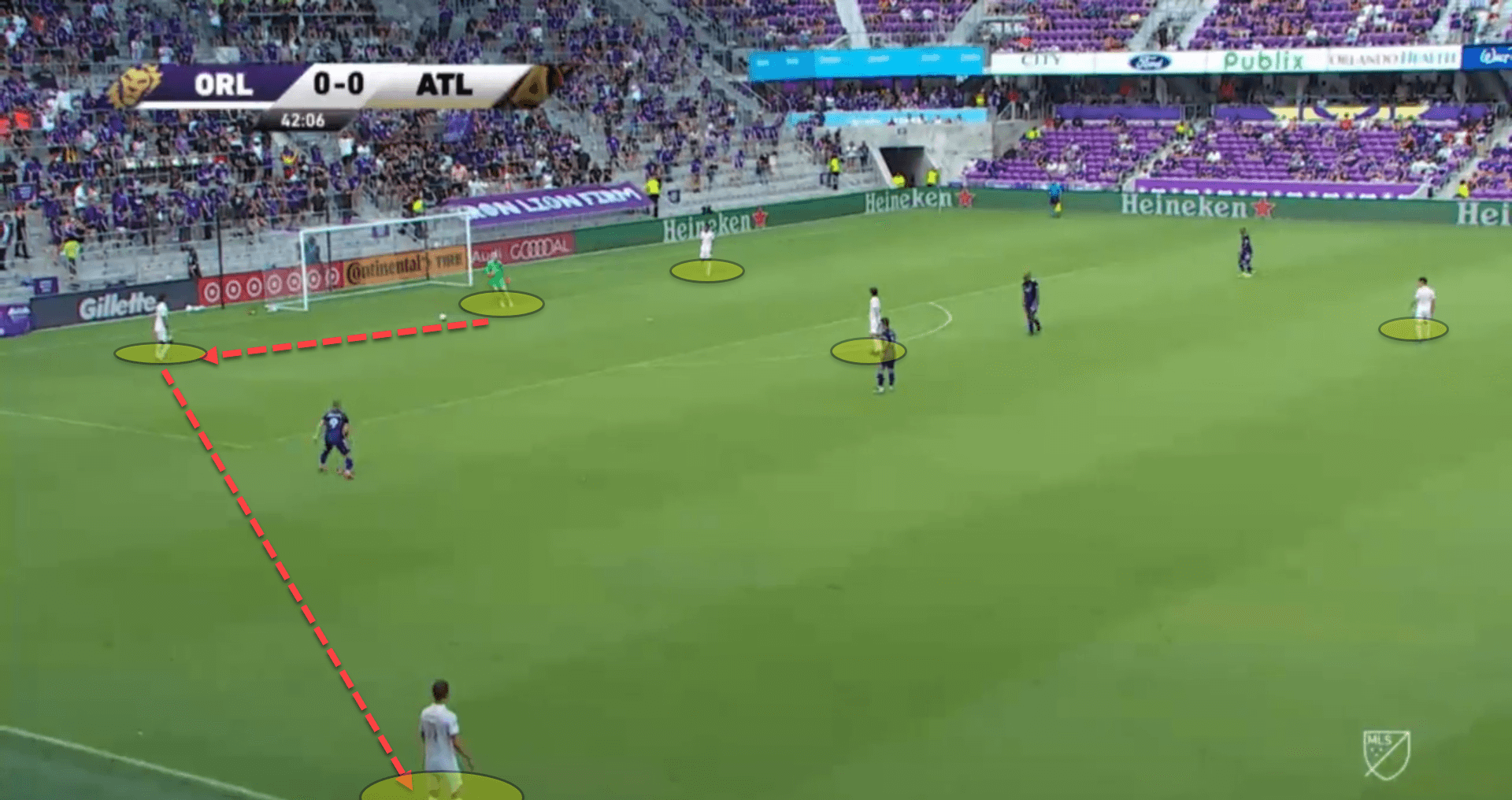
Structure higher up the pitch
Again, it would be far too difficult for me to sit here and give you a set structure that Atlanta use when they are in positional attacks higher up the pitch, looking to break down their opponent’s low block and create goalscoring chances.
They still use a three at the back which is certain but the set-up ebbs and flows depending on the situation and the space available on the pitch.
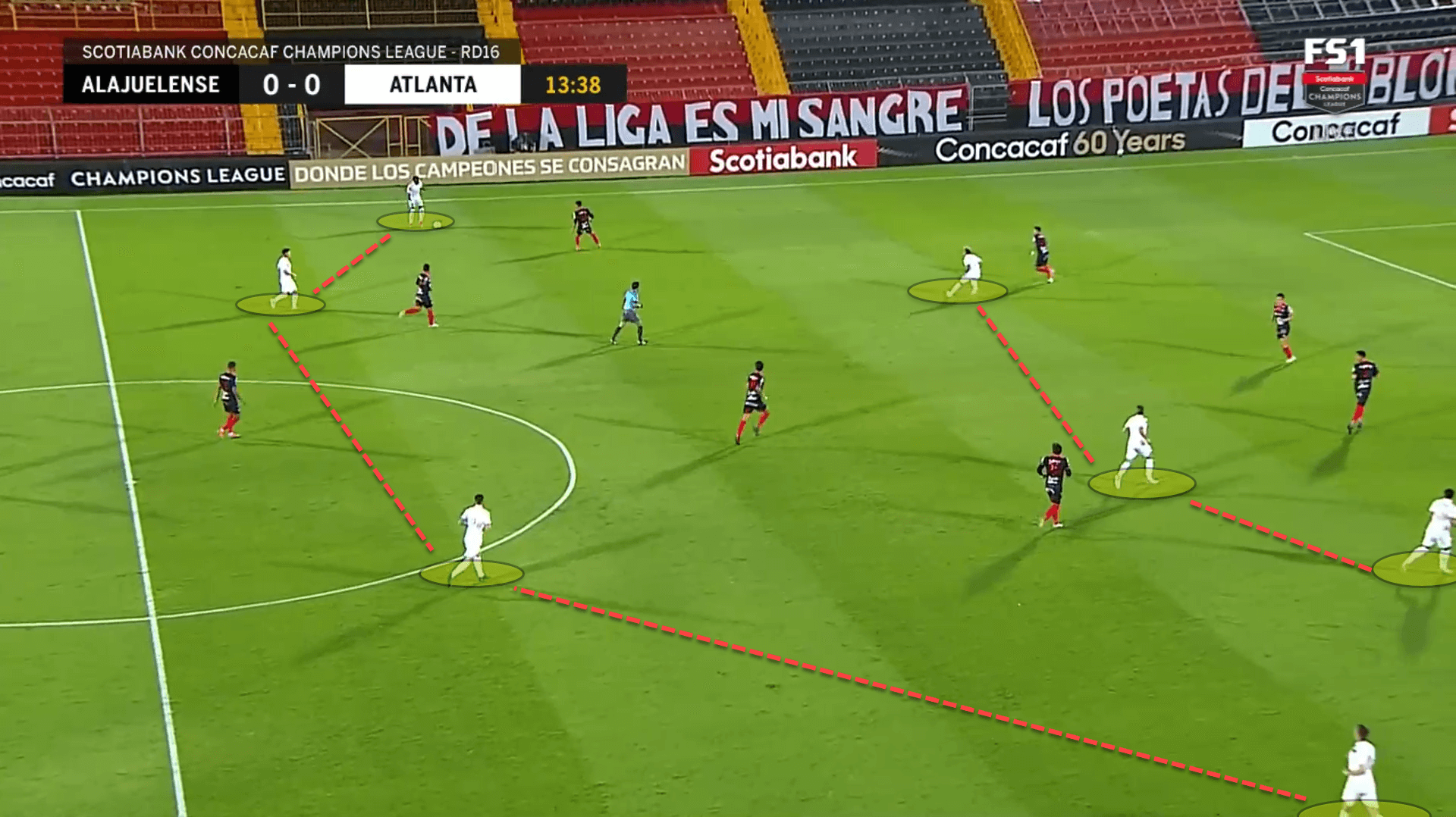
In the 3-4-3 base formation, the structure stays quite close to this although certain situational differences can vary where a player positions himself on the pitch.
Against Alajuelense, when the wingers inverted, the fullbacks stayed wide, but at times, the situation forced the winger to stay wide on the touchline and so the fullback would push inside into the halfspace. It was very clear by watching Atlanta under Heinze that the players already have an astute understanding of their own roles and the roles of their teammates as well as how to optimize space on the pitch.
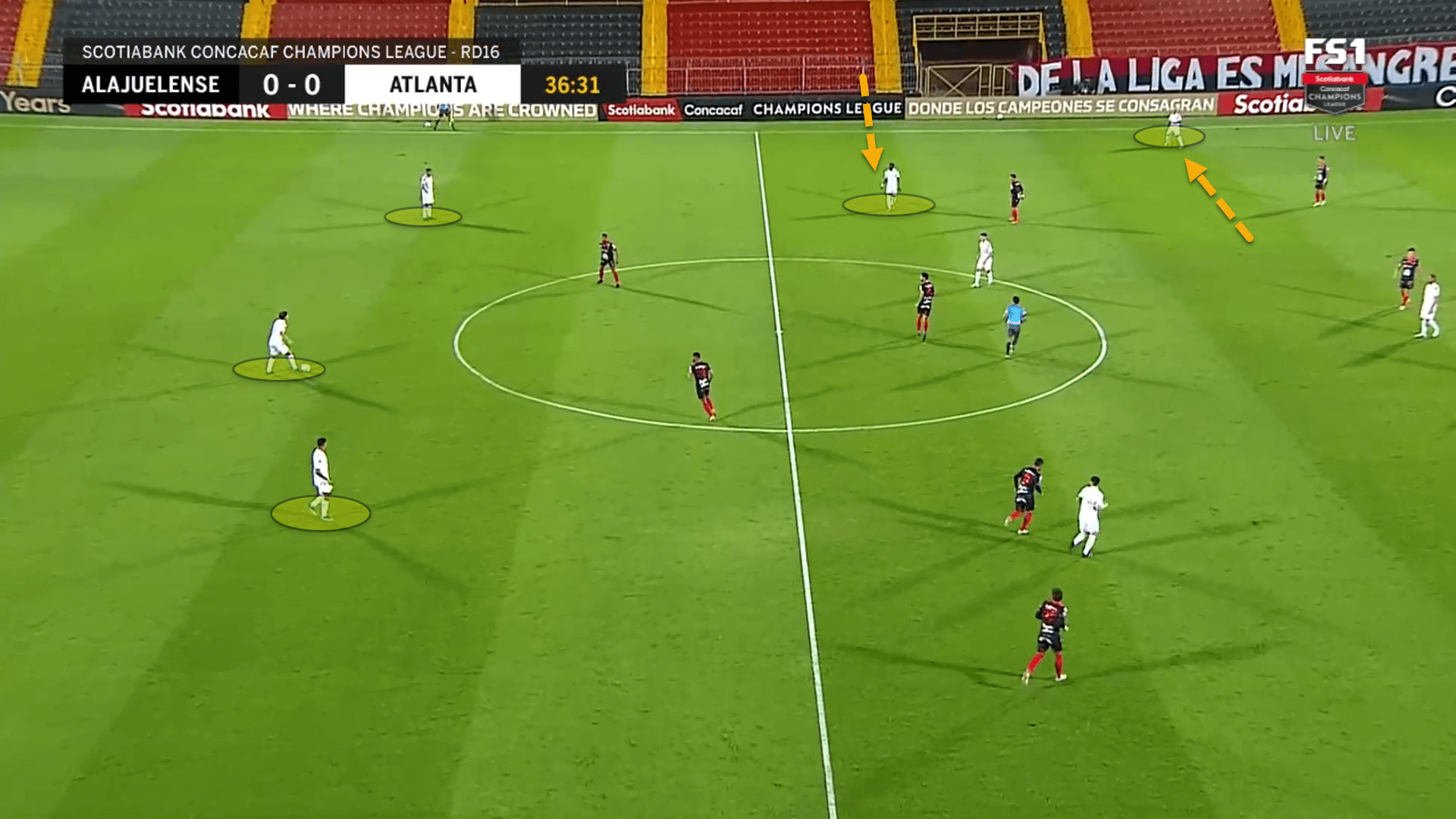
Here, Barco, who had originally positioned himself in the left halfspace, moved over to the left flank, taken up by the left-back, Bello, in order to try to take up a new position to receive the ball in as Atlanta were struggling to play through their opponents. Bello then moved into the halfspace to ensure that the overall team structure was not imbalanced too much.
In the 4-3-3/4-2-3-1 base formation, Atlanta’s shape higher up the pitch when they were looking to break down their opponent’s deep defensive block looked like a 2-4-1-3/3-1-3-3 and perhaps even a 3-3-1-3 depending on the positioning of the fullbacks, Sosa, and Hyndman in the midfield. These are the three main variables within Heinze’s system which change the most.
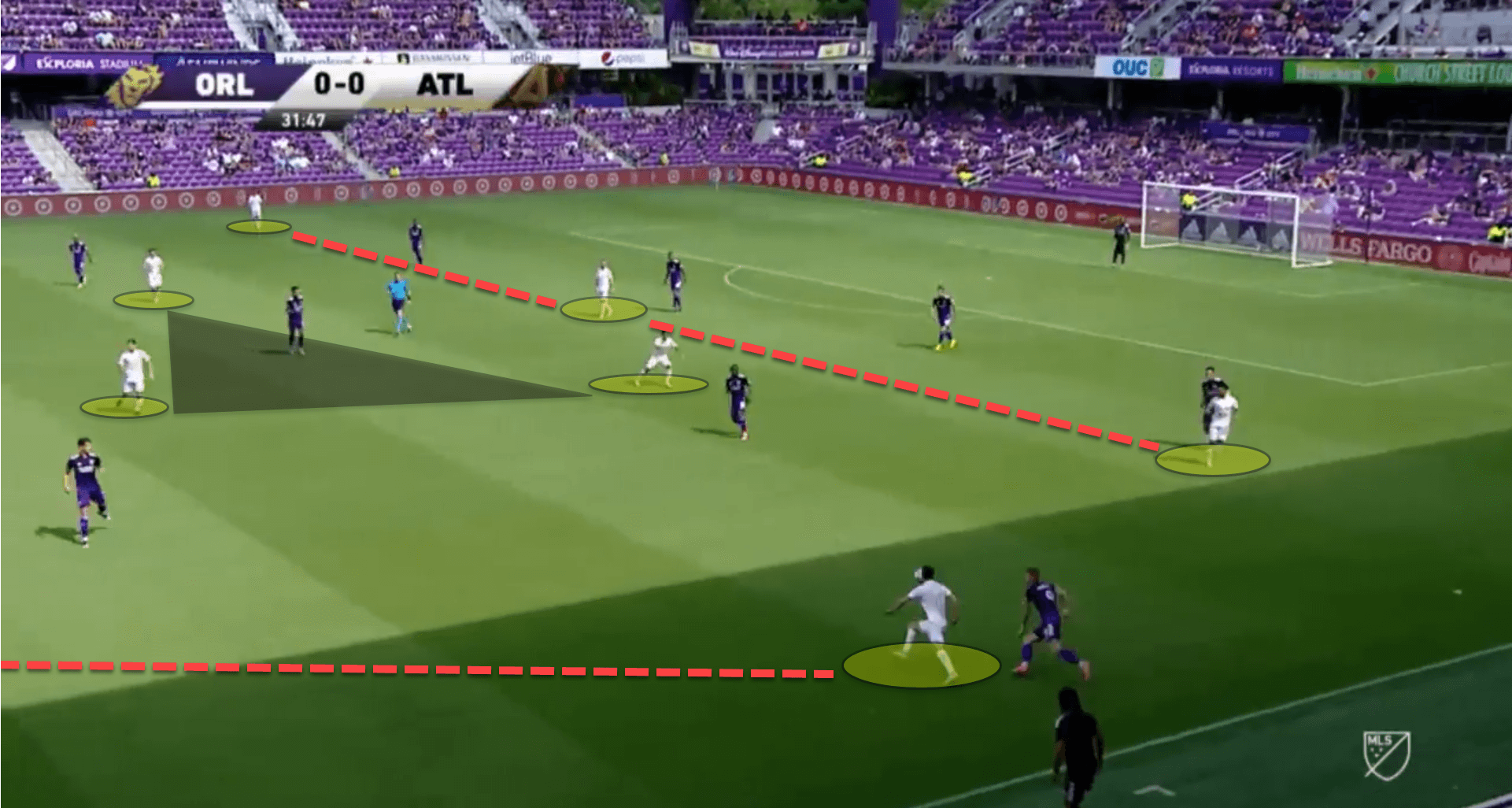
At times, Sosa would position himself behind the opposition’s first line of pressure, acting as a single midfield pivot, while Hyndman would push up between the lines, which we can see in the above image from their recent game against Orlando in the MLS.
However, on other occasions he would join Atlanta’s first line, creating a back three, meaning Hyndman would have to drop into the space behind the opposition’s first line of pressure.
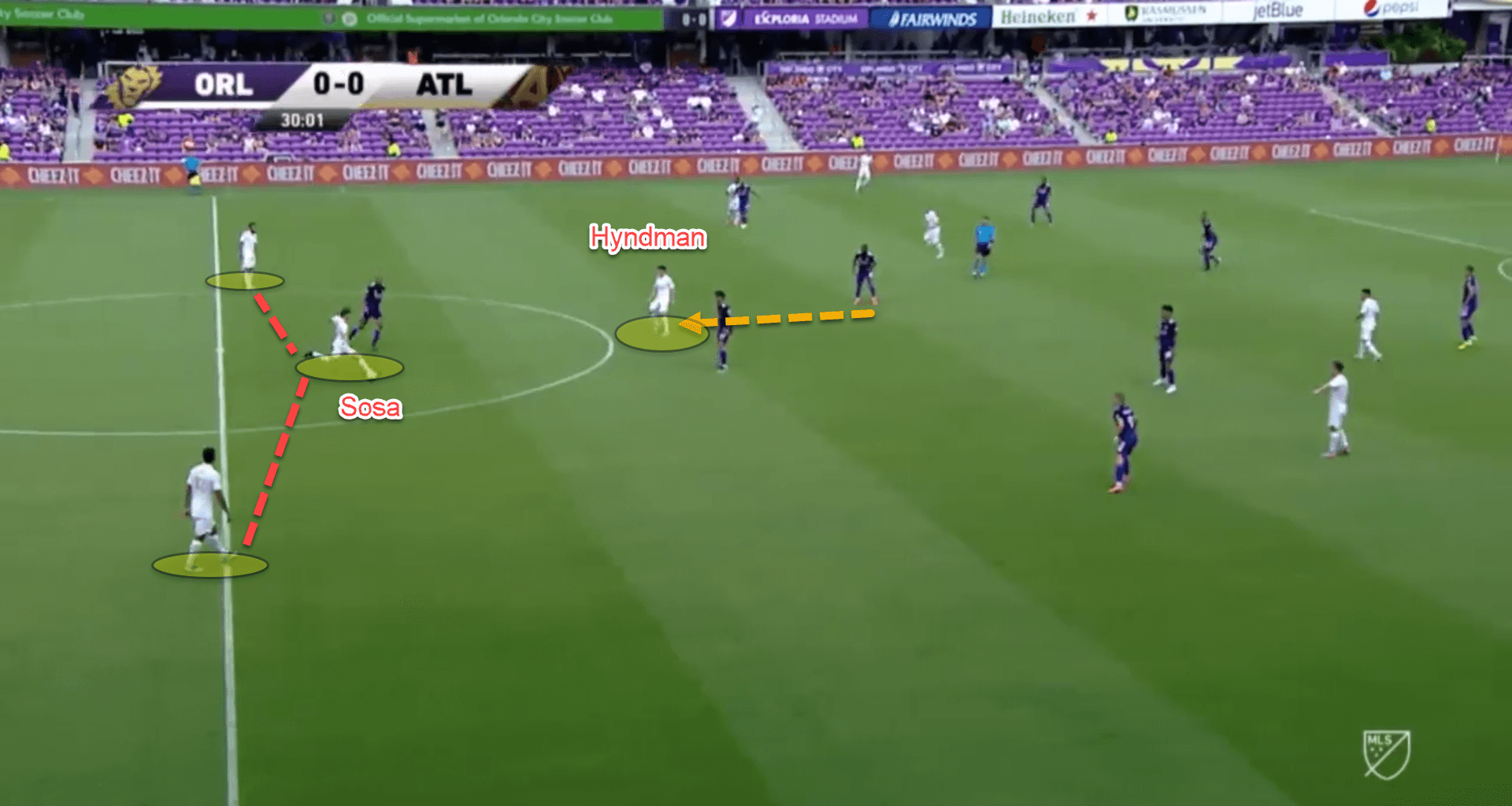
This constant fluctuation of their shape whilst in possession can be very difficult to defend against for the opposition, particularly for a team like Orlando under Oscar Pareja who defend in a zonal block.
Struggling to create and take chances
For all their beauty when they are passing the ball in triangles and making third-man runs, Atlanta have had little to show for their extensive possession. They have averaged 59.09 percent possession so far in his first three competitive games but scored just two goals, one of which was a penalty while the other was a late counterattack in the last minute against Alajuelense in the second leg when the Costa Rican side had committed most of their men forward leaving acres of space for Atlanta to run into.
Expected goals show that Heinze’s men have tallied 3.87 xG in total across those three games but have just 0.67 goals per game. They are clearly underperforming up front as when you look at where on the pitch their shots are coming from, the majority are inside the 18-yard-box.
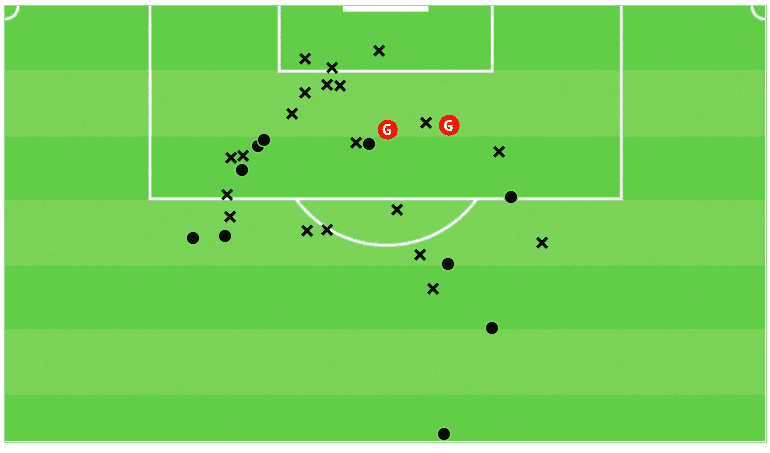
Only five of their 21 shots inside the penalty area though were on target, quite a poor record. Josef Martinez is still an option for Heinze instead of 35-year-old Lisandro Lopez up front, so perhaps we will see a lot more of him as the season progresses since Heinze will look to add more goals to his side’s play.
When attacking though, most of their chance creation is coming from the flanks and the halfspaces, from link-up play between the fullback and the wide players. These are generally overlapping and underlapping runs but work quite well for them despite the attack possibly breaking down.
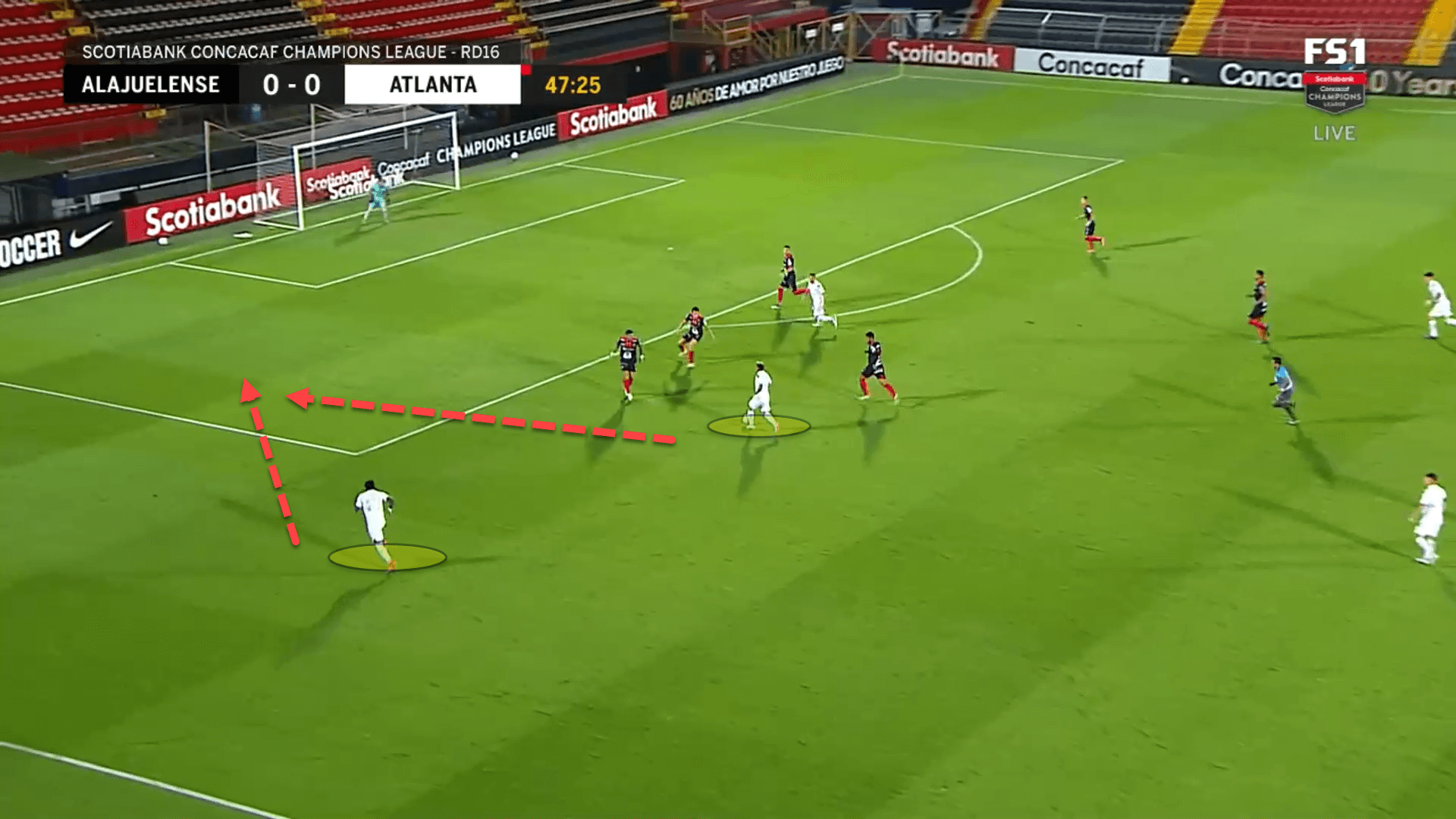
Here, we can see this type of link-up play which ultimately led to a penalty, leading to a goal. Barco received the ball in the left halfspace pocket, something he can do so well under pressure due to his ability to control the ball on the half-turn before driving at defenders, or slipping a teammate in.
Here, he did both. By him receiving the ball in this halfspace and turning, he draws the players around him towards the ball to pressure him, which leaves the fullback free in a lot of space. Barco simply slipped Bello in whose cross questionably hit the Alajuelense defender’s arm before the referee pointed to the spot.
In the two games which preceded this, Barco was moved centrally, and Moreno was played out on the left, quite a strange move from Heinze as we saw very little of these sorts of moves which can be so effective for them when they are done successfully.
The Bielsa man-marking system
Staying true to the principles of a Bielsa disciple, Heinze’s team, similarly to the San Jose Earthquakes, another club managed by a descendant of the influential coach in Matias Almeyda, play with a man-marking system out of possession.
This is something that can be effective but can also be dangerous at the same time, a system that certainly has its ups and downs.
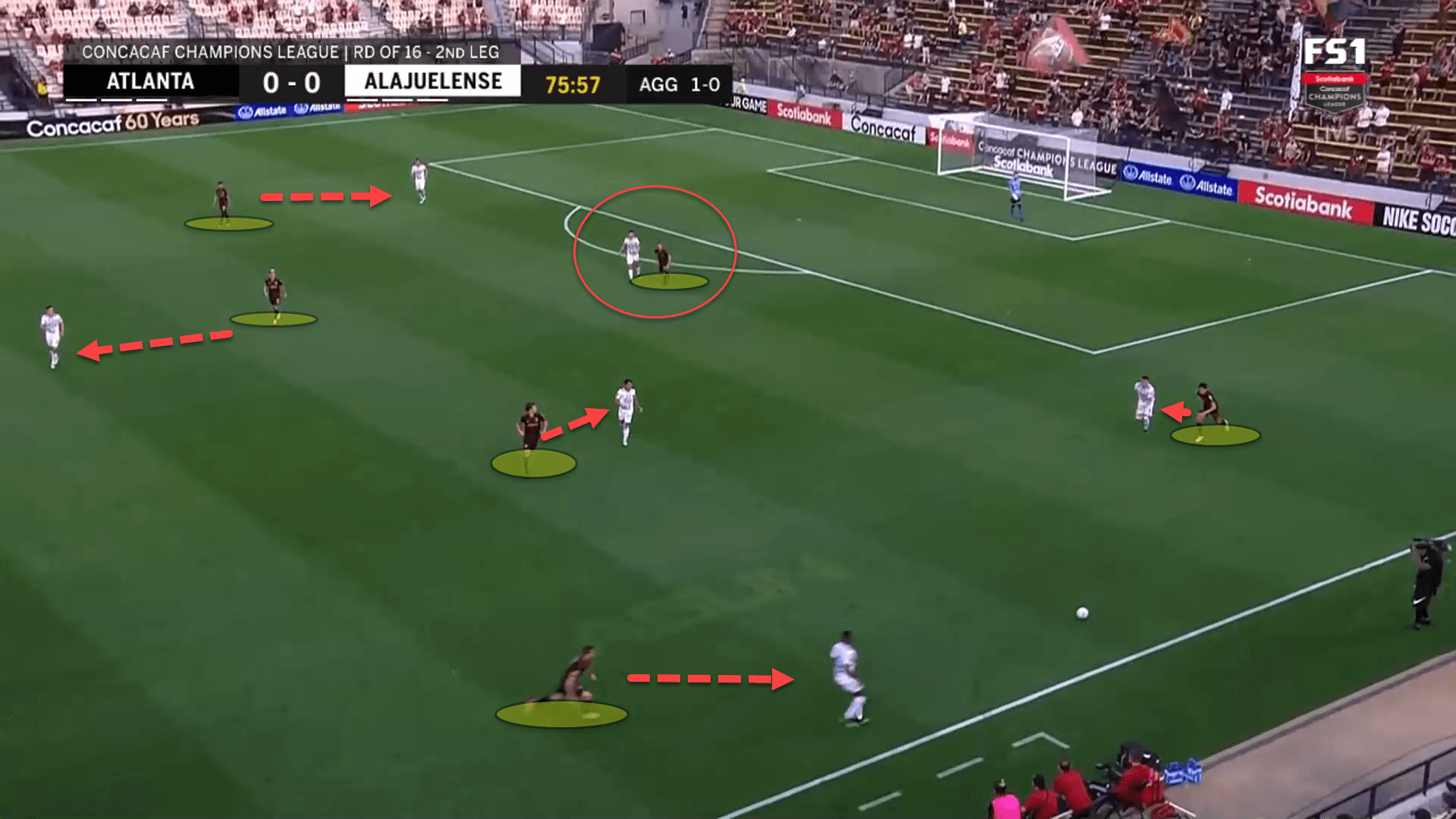
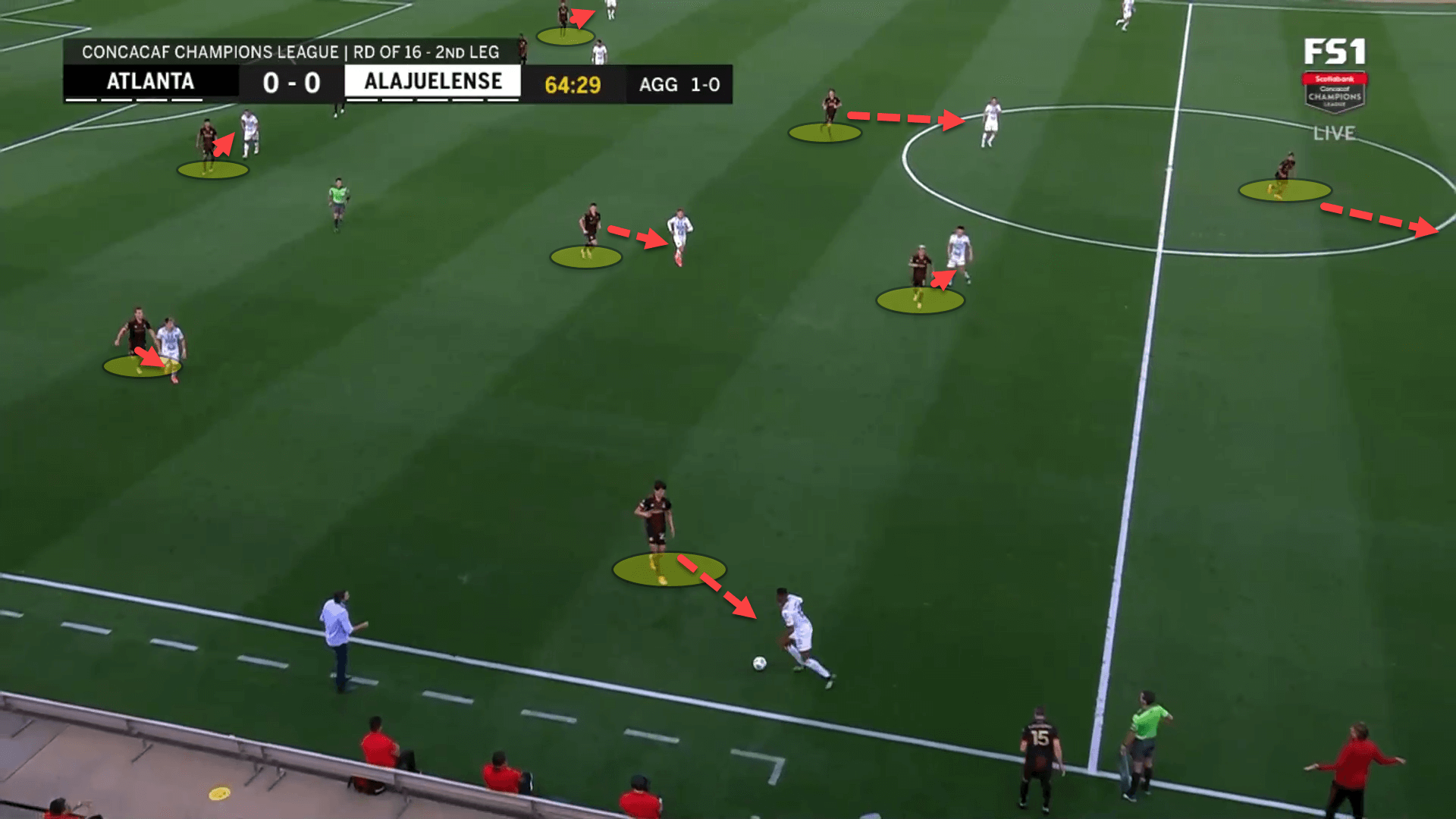
Here we can see this man-oriented marking system when they are aggressively pressing their opponents high up the pitch as well as when they are defending in deeper areas of the pitch too.
So far under Heinze, Atlanta United have averaged 7.45 Passes per Defensive Action (PPDA) in their three games, showing the intensity that the Argentine coach has them pressing at. In contrast to the opposition they have played, Atlanta’s PPDA against is 18.93.
Like every style of play in football, there are problems with how the Five Stripes defend. One of the main weaknesses of a man-marking system out of possession is that if there is a weak link within the system, the entire chain is at risk of collapsing. For Atlanta, if one of their players does not stay with their man, it can be very easy to play through them and can create situations where one of their players are being outnumbered 2v1 by the opposition’s attacking players.
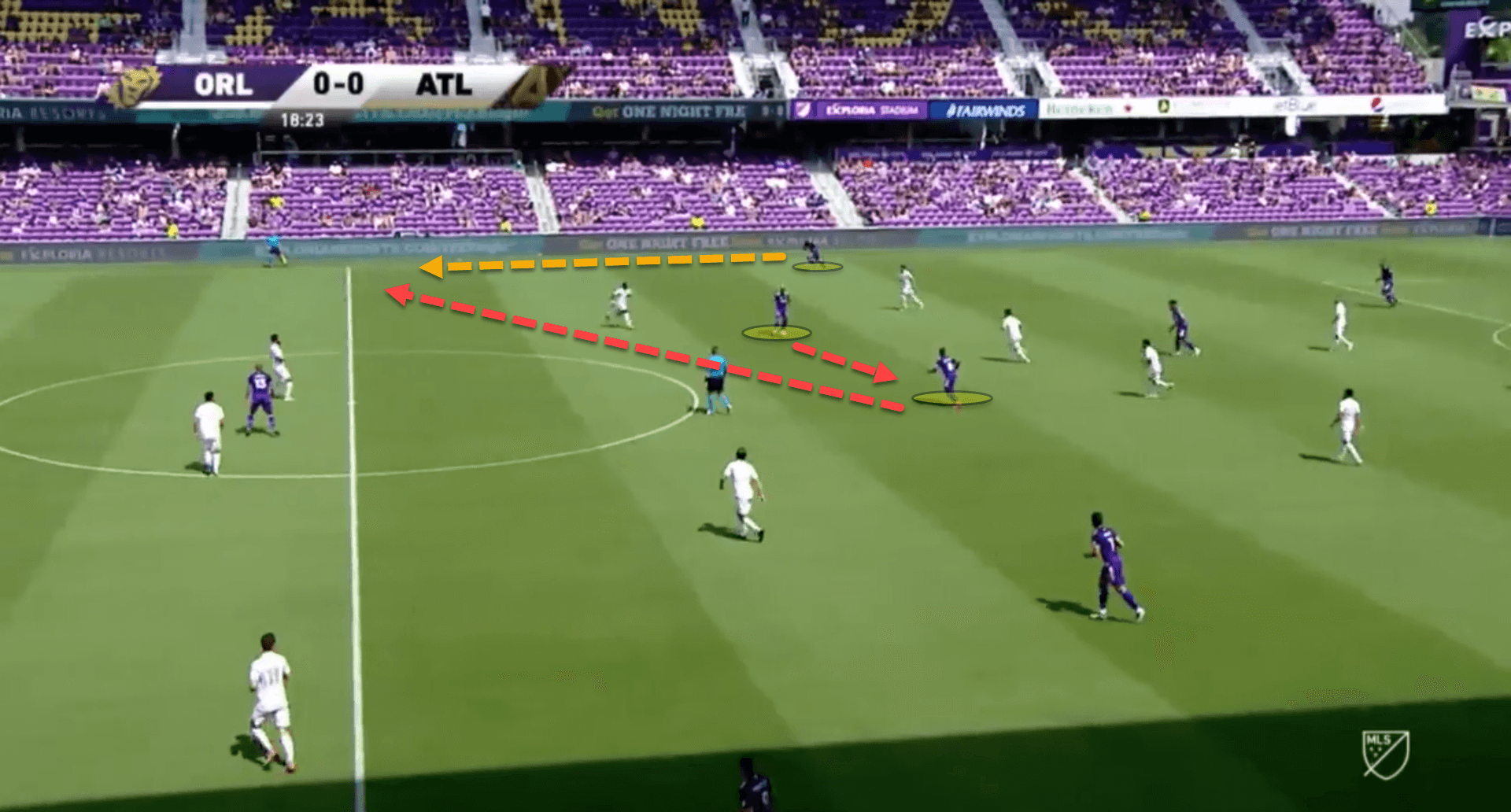
Here, multiple Atlanta players have failed to close down the nearest player for Orlando, which has left their opponents with a lot of space to exploit over on the left defensive flank on the fullback’s blindside.
Another weakness that Atlanta have in their defensive phases is that they are quite poor at applying cover shadows when pressing. Cover shadows are more notorious with zonal systems as you can essentially take out two players with one player by blocking the passing lane in behind the defending player while he/she presses the player on the ball.
However, since Atlanta play with a man-marking defensive system, the players are not worried about applying a cover shadow to the passing lane behind them when pressing, but this can sometimes make it very easy to bypass a player when he presses the ball-carrier and play it into the man positioned behind him.
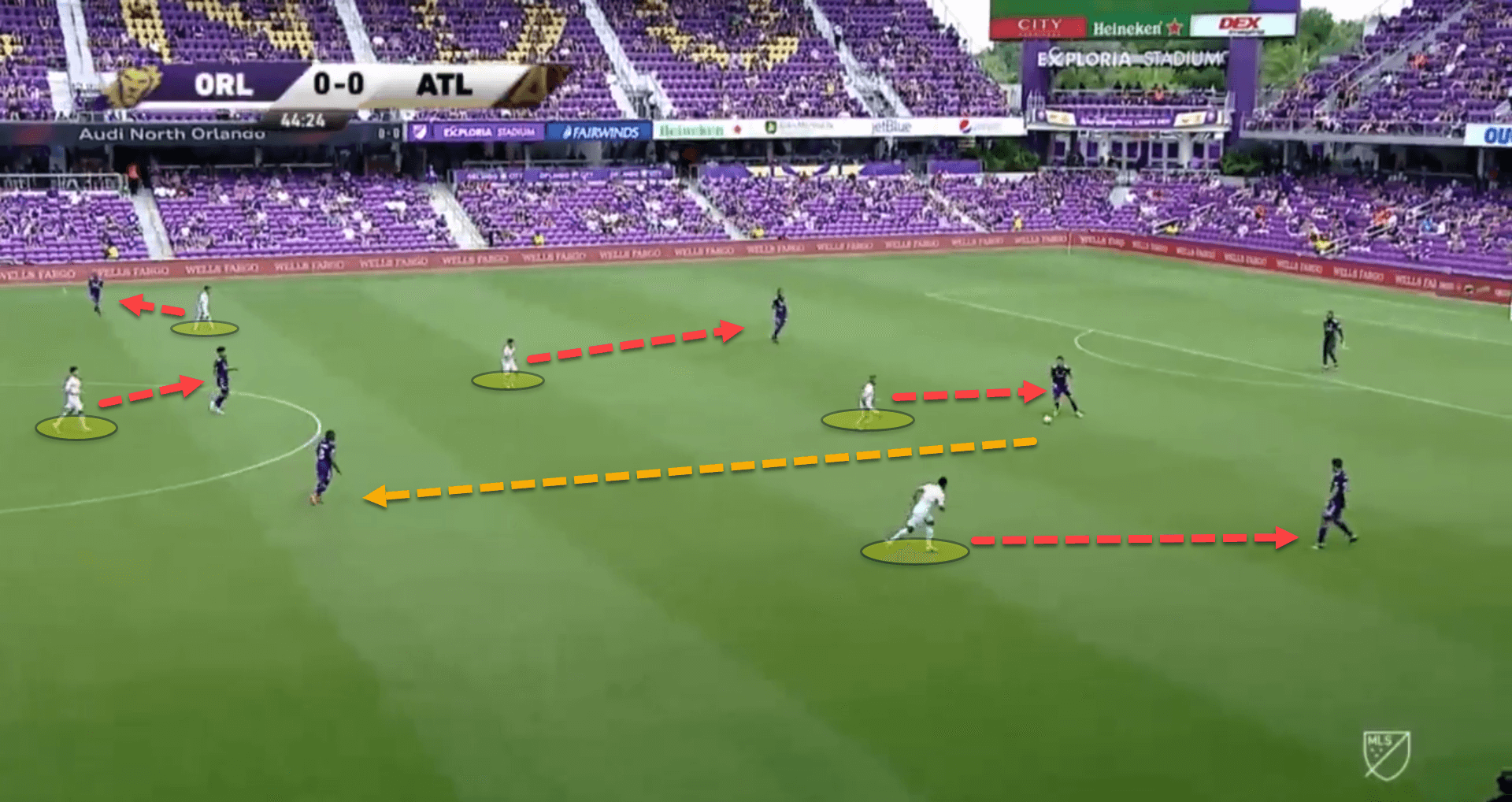
That being said though, Atlanta have yet to concede in a competitive game under their new manager so the methods he has used so far have been quite successful if not slightly radical.
Conclusion
Atlanta United have shown already under Heinze that they will quite possibly be one of the most exciting teams if not the most exciting team in the MLS in the current campaign. In possession, the movement of their players to take up new positions to receive the ball can be a joy to watch at times, and even out of possession, their incredible work rate is nothing short of commendable.
There are still quite a few deficiencies in their game, particularly with their goalscoring abilities, but if Heinze can find a way to rectify these issues, he may be in for a great season with his new club.






Comments